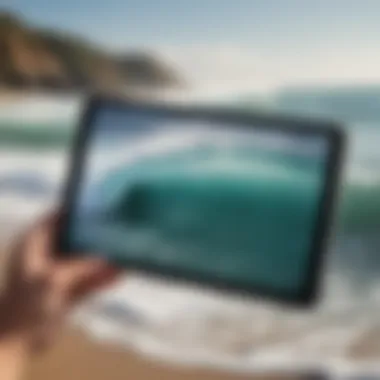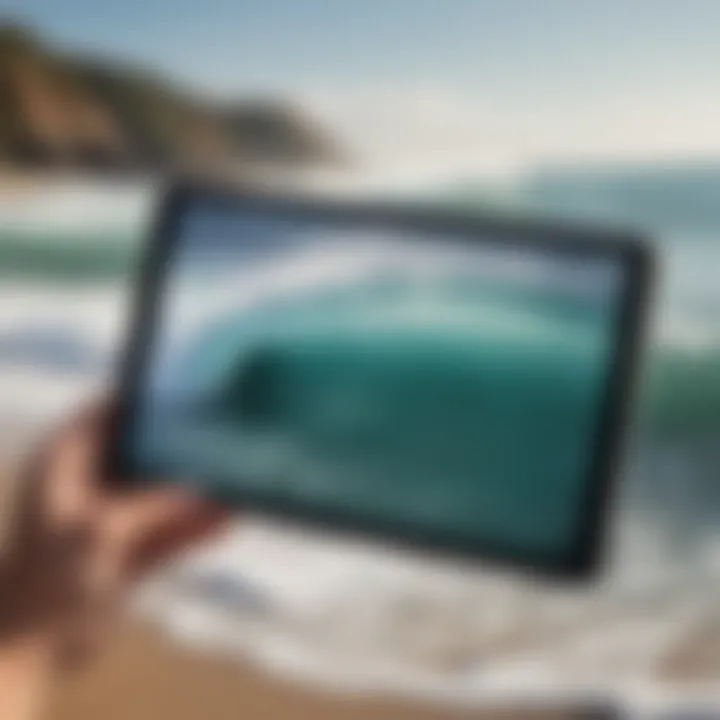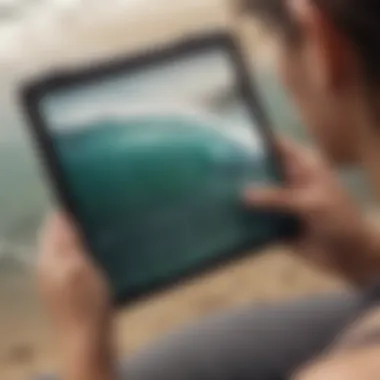Exploring Surf Tablets: Elevate Your Surfing Experience


Intro
In a world where technology often intertwines with sports, surfing stands as a unique sanctuary where the ocean meets innovation. For surfers, the experience holds a blend of freedom, thrill, and sheer connection with nature. However, this relationship is evolving with the introduction of surf tablets, specialized devices that promise to enhance every wave chase, from the novice paddling out for the first time to the seasoned rider mastering their next big move.
Surf tablets offer various functionalities designed to elevate the overall surfing journey. Whether it’s tracking conditions, honing techniques, or connecting with fellow enthusiasts, these gadgets can provide a wealth of information right at your fingertips. Throughout this article, we will journey into the realm of surf tablets, shining a light on their features and benefits, while also delving into potential downsides. As we explore their applications in navigation, training, and community engagement, it becomes clear that these devices are more than just another gadget; they can reshape how surfers interact with the waves and each other.
From this discussion, you will glean insights and practical tips to help you select the right surf tablet, ensuring it meets your specific needs in the water. Let’s delve into this exciting technology and unveil what it can do for surfing enthusiasts well-versed in ocean lore or those who are just setting off on their wave-riding adventure.
Understanding Surf Tablets
In the context of modern surfing, understanding surf tablets is pivotal for optimizing the experience on the water. These high-tech devices cater to both newbies and seasoned surfers by providing essential insights into wave conditions, navigation, and performance tracking. They serve a dual purpose—not only do they enhance user safety by offering communication tools, but they also ramp up enjoyment by helping surfers pick the right waves at the right times. Let's break down why a grasp of surf tablets is vital for anyone passionate about riding the waves.
Definition and Purpose
A surf tablet can be defined as a portable device designed specifically for surfers, integrating various tools and features aimed at enhancing their performance and safety in the water. It's equipped with software that relates directly to surfing such as wave forecasting, GPS tracking, and often includes apps tailored for surfers.
The primary purpose of these devices is to make the surfing experience more enjoyable and informed. Picture yourself paddling out into the ocean, knowing exactly which direction to head for the best swells, all thanks to the data your tablet provides. Whether you're scouting the day's best break or tracking your own progress over time, a surf tablet acts as a trusted companion, blending technology with the art of riding waves.
Evolution of Surfing Technology
The development of surfing technology has been quite remarkable. In the early days, surfers relied heavily on local knowledge and instinct to find the best spots. However, advancement in technology marked a significant shift. Initially, surf forecasts were based on rudimentary charts and tides, which limited the precision of information available to a surfer.
Now, thanks to innovations like digital applications and smart devices, surfers can tap into real-time data about wind speeds, wave heights, and even water temperatures. This evolution doesn't merely enhance performance; it fundamentally changes how surfers interact with the ocean. From early handheld devices that were often cumbersome, surf tablets have refined the interface, providing sleek displays with touch capabilities and user-friendly applications.
"The ocean is a living thing, and technology has given surfers a lens to see it clearer."
With advancements in weather modeling and data analytics, surf tablets can predict swell patterns with impressive accuracy, allowing surfers to plan their sessions better. Thus, the leap from traditional knowledge to tech-savvy surfing has opened up a new world for enthusiasts and professionals alike, fostering a deeper connection between surfers and their environment.
Key Features of Surf Tablets
Understanding the key features of surf tablets is crucial for surfers aiming to maximize their time on the waves. These specialized devices pack a punch with capabilities designed to enhance the surfing experience, making them invaluable tools. When choosing a surf tablet, one should consider several important elements, benefits, and how they adapt to the unique needs of various users.
Water Resistance and Durability
One of the standout features of surf tablets is their water resistance. Unlike a typical tablet, which may succumb to moisture, surf tablets are built to withstand splashes, waves, and even occasional dunkings. This quality is vital for those who take a wipeout or two. You don’t want to be worrying about your gear when you should be focusing on keeping your balance.
Durability is equally important. Surfers often find themselves in unpredictable conditions, with salt, sand, and sun all being part of the package. A rugged construction that can handle rough treatment without faltering ensures the tech remains reliable. Look for models that boast military-grade protection or at least an IP rating of 67 or higher for peace of mind.
Display and Usability
Having a clear view matters, especially when you want to check surf conditions, navigation, or even track your performance in the waves. Surf tablets typically feature bright, high-resolution displays, making it easy to read under the sun. The usability extends to touchscreen functionality, which is often optimized for wet fingers.
A good display isn't just about size; it's also about responsiveness and legibility. It’s worth mentioning that some surf tablets come with anti-glare screens, ensuring you can see information clearly, regardless of the sun's harsh glare. User interfaces are also designed with surfers in mind, simplifying navigation so that even those less tech-savvy can find what they need without fuss.
Battery Life Considerations
When you’re out on the water, the last thing you want is to run out of juice on your surf tablet. Battery life can’t be overlooked. Different models offer varying battery performance, and this factor can influence your choice significantly. Many surf tablets provide extended battery life, often lasting a full day of use without needing a recharge.
Consideration for energy efficiency is also essential. Look for tablets that offer power-saving modes or smart adjustments based on usage. You want a device that won’t let you down when you rely on it the most, be it for monitoring conditions or tracking your session over the waves.
"A good surf tablet doesn't just get you through the day; it enhances your overall experience, allowing you to focus on the surf while your device keeps you informed."
In summary, when assessing surf tablets, one must prioritize water resistance, durability, display quality, usability, and battery life. Each of these features directly impacts how well the device performs in real-world surfing situations, ensuring the surfer can stay immersed in their craft without unnecessary distractions.
Benefits of Using Surf Tablets


Surf tablets are increasingly becoming an integral part of the surfing experience. For surf enthusiasts, utilizing these devices can significantly enhance their time on the water. This section sheds light on some of the primary benefits of using surf tablets, focusing on how they can amplify navigation skills, track surf conditions, and provide insights into personal training. In an age where technology marries sports, understanding these benefits can empower surfers, from seasoned pros to newbies, to make informed choices that cater to their unique needs.
Enhanced Navigation Capabilities
Surf tablets offer advanced navigation features that can transform how surfers approach the ocean. Imagine paddling out and effortlessly knowing where the best breaks are located, all thanks to real-time mapping. Many surf tablets come equipped with GPS and tidal data, allowing surfers to navigate unfamiliar waters with ease. This becomes invaluable during trips to new surf spots where local knowledge can be scarce.
Moreover, surf tablets can display key information like wave height forecasts, the direction of swells, and currents. By tapping into resources like weather apps or surf forecasts, surfers can make better decisions on when to hit the waves. This not only maximizes time spent on the water but also enhances safety.
"With navigation technology at your fingertips, the ocean becomes a canvas versus a challenge."
Surf Conditions Monitoring
Understanding surf conditions is critical for every surfer. Surf tablets can monitor conditions in real-time, providing surfers with updates on wave height, wind speed, and beach conditions. Instead of relying solely on anecdotal information or static reports, surfers can access current data while at the beach.
For example, many surf tablets use advanced sensors to track real-time weather patterns. This allows surfers to avoid tricky conditions and choose the best moments to ride. The ability to check conditions on-the-go can save time and reduce the chances of heading out for a subpar experience.
In addition, using these tablets can engage surfers with communities that discuss and share surf conditions. Forums on platforms like Reddit or specific Facebook groups can be integrated into apps, so surfers can exchange insights, expanding their knowledge beyond just personal observation.
Training and Performance Tracking
For those serious about honing their skills, surf tablets can also play a pivotal role in training and performance tracking. These devices often come with apps that can analyze techniques and monitor progress over time. Surfers can log details about their rides, noting aspects like speed, duration, and wave types.
This can prove vital for instructors coaching beginners or advanced surfers looking to fine-tune their performance. Imagine being able to highlight areas where you struggle or to see consistent improvement in your technique through tracked metrics.
Data can be analyzed to reveal tendencies, weaknesses, and strengths, helping surfers adjust their training regimens accordingly. Whether working on paddling strength or wave mastering, quantifying performance can be a game-changer.
In summary, surf tablets can provide a comprehensive suite of tools that not only enhance the surfing experience but also inform and protect those who take to the water. From improved navigation to real-time condition monitoring and performance tracking, these devices have become essential companions for serious ocean adventurers.
Potential Drawbacks of Surf Tablets
While surf tablets bring a boatload of advantages to the table, it’s crucial to acknowledge their potential drawbacks as well. Understanding these concerns is just as important as recognizing the benefits, as technology, despite its enhancements, can also lead surfers down a rocky path if they're not careful.
Reliance on Technology
One of the most significant downsides is the tendency to lean too heavily on technology. Surfers who become overly dependent on their surf tablets may neglect traditional skills and instincts honed over years of experience. When relying on devices for navigation and surf conditions, it’s easy to lose that intuitive feel for the ocean. Besides, if a tablet runs out of battery or malfunctions, it can lead to a situation where a surfer feels adrift—both literally and figuratively.
Furthermore, during a surf session, the natural surroundings can sometimes be overpowering. A loud notification from a tablet can break the rhythm of a serene ride or distract a surfer just when they need their focus the most to catch a wave. In environments where instinct and awareness are key, technology can become a double-edged sword.
Cost and Accessibility Issues
Let's not sugarcoat it—surf tablets are not exactly a penny-pincher's best friend. Most models come with a hefty price tag, which can deter some prospective users. With budgets already stretched thin from purchasing gear and planning trips, the expense of a top-tier surf tablet may simply be too much.
Additionally, there's the glaring issue of accessibility. Not all locations are equipped with the internet speed needed to support high-functioning surf applications. For surfers living in remote areas, this could mean their tablets don’t function at full capacity. In regions where advanced technology isn’t readily available, relying on such a device can be more hassle than it’s worth.
Moreover, while the market has opened up to include a variety of manufacturers, not every tablet on the market is created equal. Some may lack specific features that others boast, which could leave users frustrated and at a disadvantage in competitive situations. Not to mention, certain surf tablets are less user-friendly, making it difficult for less tech-savvy surfers to leverage their full potential.
"A great wave is the feeling of being in sync with nature; don’t let gadgets take that away from you."
Real-World Applications of Surf Tablets
Surf tablets are not just fancy gadgets; they serve a significant role in enhancing the surfing experience across various contexts. From professional competitions to recreational outings, these devices provide crucial support, whether it's navigating tricky waters or analyzing one’s performance. Understanding how they are applied in real-world scenarios gives surfers a clearer insight into their utility and impact.
Competitions and Professional Use
In competitive surfing, every wave counts. Surf tablets have become an essential tool for professional surfers during contests. They offer real-time data on wave patterns, weather conditions, and even tide movements, allowing surfers to make informed decisions. Consider the scenario of a surfer participating in the World Surf League. With a surf tablet, they can access detailed weather forecasts and sea conditions, optimizing their strategy for the day. For example, a surfer might notice that certain spots are favored based on wind direction and adjust their approach accordingly.
Moreover, surf coaches are increasingly using these devices to analyze performance. Using video analysis and data tracking features, they can pinpoint strengths and weaknesses. This kind of feedback loops into their training regimen. Surfers can see footage of their previous rides, with annotations on their technique and timing. Such insights can be crucial when preparing for the pressures of competition, giving advantages that might mean the difference between victory and defeat.


Recreational Use for Every Skill Level
Not just for the pros, surf tablets are a game-changer for surfers of any skill level. They democratize access to tools that enhance the surfing experience, making them suitable for anyone from novices to seasoned surfers. For those just starting out, surf tablets can be a valuable learning aid. Many come equipped with tutorials and training modules that help users understand fundamental techniques and safety protocols.
Even casual beachgoers can benefit. Imagine spending a day at the beach with friends, and someone pulls out a surf tablet. You can check real-time surf conditions or find popular spots nearby, all while enjoying the sun. It creates a richer experience, transforming a standard beach day into a more engaged adventure.
For the more experienced surfers, these devices often feature advanced metrics like speed, wave height, and even performance graphs over time. Tracking one's progress can become an intrinsic part of the journey. If a surfer begins to notice particular trends about their performance, like consistently catching bigger waves, it can lead to enhanced confidence and motivation.
"In the age of technology, surf tablets connect us not just to the waves, but to a broader community of surfers, offering resources, insights, and a sense of unity in the surf culture."
This application of surf tablets fosters a community-oriented environment. Platforms built around surf tablets create forums for sharing experiences and tips, benefiting users with a sense of camaraderie and connection.
To wrap up, surf tablets have significant real-world applications across different surfing scenarios, effectively bridging the gap between casual enjoyment and professional rigor. The analytical tools they provide enhance learning and growth while fostering a deeper community connection. As technology continues to evolve, so too will the roles these devices play in the surfing world.
Choosing the Right Surf Tablet
Selecting the appropriate surf tablet is not just about picking a shiny gadget; it’s a crucial decision that can significantly enhance a surfer's experience. The right device can offer features that make a marked difference on the water, from navigation to real-time surf conditions monitoring. As surf tablets cater to various skill sets, knowing what fits your personal needs and preferences can ensure that you get the most out of your surfing endeavors. An informed choice can mean the difference between feeling frustrated with outdated technology and riding the waves with confidence and clarity.
Identifying Personal Needs
Understanding one’s own personal requirements goes a long way in the sturdy world of surf tablets. Ask yourself a few questions: Are you a recreational surfer looking for reliable weather updates? Or are you a competitive surfer who needs advanced data analytics to track your performance? The answers to these questions can help narrow down the multitude of options available in the market.
- Skill Level: For novice surfers, a basic model with essential features may suffice, focusing on user-friendliness. On the contrary, seasoned surfers might prefer a model packed with advanced tools and analytics.
- Amenities: Consider the types of features that are game-changers for you. For example, some tablets offer a built-in compass and GPS, which can be great for adventurers heading to less familiar spots.
- Size and Portability: Does it fit snugly in your wetsuit pocket? Be mindful of the device's dimensions. A large tablet is great for visibility, but it might be cumbersome when you're out on the waves.
Comparison of Top Models
When it comes to making an informed decision, looking at the top models in the market is key. A little bit of comparison shopping can leave you less likely to regret your choice. Here’s a snapshot of some of the standout surf tablets you might want to consider:
- Waveloop Pro
- Surfer’s Companion Tab
- OceanTracker Tablet
- Size: 10 inches
- Features: Ultra-responsive touchscreen, water resistant up to 3 meters, and offers wave forecasts.
- Battery Life: Up to 12 hours, perfect for those all-day surf sessions.
- Size: 8 inches
- Features: Compact design, built-in surf community features, good for social connections among surfers.
- Battery Life: 10 hours, with speed alerts for real-time conditions.
- Size: 9 inches
- Features: Advanced wave analytics, waterproof and drop-proof with a rugged design, suitable for competitive surfers.
- Battery Life: 15 hours, giving ample surf time even in a long competition day.
Regardless of which model catches your eye, make sure it aligns seamlessly with your surfing ambitions. Investing in the right surf tablet could open new dimensions in both your skills and your overall experience in the water.
"The best surf tablet isn’t the one that impresses others; it’s the one that meets your needs perfectly".
Surf Tablets and Ocean Safety
As surfing continues to evolve with technology, surf tablets have emerged as critical tools not merely for enhancing performance but primarily for improving safety in our beautiful, yet unpredictable ocean environments. When you think about being out on the water, it’s not just about riding the waves; it’s about ensuring you are aware and prepared for any situation. Surf tablets serve as multifaceted devices that can play a pivotal role in promoting ocean safety.
Utilizing Surf Tablets for Emergency Situations
In the throes of nature, accidents can happen in the blink of an eye. This is where surf tablets really come into their own. Equipped with features such as GPS tracking and real-time weather updates, surf tablets offer more than just basic functions.
For instance, imagine finding yourself in choppy waters, your board slipping away and the ocean swells becoming fiercer. A surf tablet can quickly relay your location to emergency services. This mitigates devastating scenarios. Users can set emergency contacts to receive alerts or updates about their whereabouts during a surfing session, ensuring that someone knows if something goes awry. Here are some features that make surf tablets invaluable during emergencies:
- Real-time GPS Location: Provides precise location data to rescuers.
- Weather Alerts: Immediate notifications about changes in weather can prevent dangerous conditions.
- SOS Features: Quick-send alerts can be initialized for emergencies, automatically contacting help without fumbling in panic.
"When you’re out there catching waves, having a reliable surf tablet can mean the difference between a close call and a dangerous situation."
With these features, surfers can feel less like lone wolves and more like part of a community that values safety alongside fun.
Enhancing Safety Procedures


Beyond emergency scenarios, the proactive use of surf tablets can significantly enhance daily safety procedures for surfers. They can integrate safety features directly into your regular surfing routine.
Using applications designed for surf tablets can help monitor tides, wave conditions, and even local marine life activities that might pose a risk. Here’s how surf tablets can streamline safety measures:
- Tide and Wave Reports: Surf tablets provide accurate data regarding tides and swell patterns. This allows surfers to pick optimal times for hitting the beach, steering clear of too risky conditions.
- Safe Surfing Zones: Apps can highlight safer spots along the coastline, taking local knowledge right to your fingertips.
- Group Surfing Safety: When surfing in groups, a tablet can allow for easier tracking of discrepancies in location, ensuring everyone stays connected and safe.
The integration of social features facilitates real-time communication among surfers, enabling a community-centered approach to ocean safety. No more leaving your mates in the lurch; everyone stays accounted for while enjoying the thrill of the water.
As more surfers embrace technology, the responsibility grows to ensure its use actively promotes health and safety in our surf culture.
The Impact of Surf Tablets on Surf Culture
The rise of surf tablets has brought a seismic shift to the culture surrounding this beloved sport. No longer just a pastime enjoyed with the roar of the waves and the salt in the air, surfing has evolved into a more tech-savvy experience. Surf tablets are not only enhancing the practical aspects of surfing but also fostering a sense of community among enthusiasts, while simultaneously promoting the importance of environmental stewardship. Let’s break this down further.
Connecting the Surf Community
Surfing, at its core, has always been about connection — to the ocean, to the waves, and to each other. Surf tablets are modern tools that further this bond. Through various applications, surfers can share conditions, locations of the best swells, and even set up meet-ups at favorite spots. There's a camaraderie that comes from sharing the waves with friends and fellow surfers, and these devices make it easier than ever to connect with others.
Imagine you're at a beach like Huntington or Waimea, where the surf scene is alive with excitement. Instead of just waiting for your buddies to show up, you can send out a quick message using a surf app to gather your crew as soon as that perfect set begins to form. Whether through message boards or live updates, the information flows like water, enhancing the experience for everyone involved.
"Technology can be a sandbar on which relationships are built rather than broken."
Moreover, social media platforms like Reddit and Facebook are integrating user-generated content about surf spots and personal experiences. This way, riders can exchange tips and local surf culture seamlessly, bridging distances and helping to establish not just a local scene but an expansive global network of surfers. As communities grow in strength and size, so too does the sense of identity that comes from being part of a passionate group.
Promoting Environmental Awareness
Beyond connectivity, surf tablets can serve as catalysts for environmental awareness. Given that surfers are inherently tied to the ocean, many tablet applications focus on sustainability and conservation efforts. Users can easily access real-time data about water quality, weather patterns, and local environmental initiatives. This information is vital for making informed decisions that can protect their ocean playgrounds.
Surfers often have a deep love for their environment, and when technologies provide them with the ability to report pollution or harmful conditions, it fosters responsibility within the community. Apps can also contribute by promoting eco-friendly surfing practices, emphasizing the need to reduce plastic usage and offering insights on how to maintain clean beaches.
Here are some initiatives surf tablets may support:
- Monitoring local beaches for debris and pollution.
- Educating surfers about the importance of ocean conservation.
- Generating reports on sustainable practices that can be easily shared across surf communities.
Surf tablets thus play a dual role — they’re not just enhancing the surfing experience, they’re fostering a culture that respects and protects the waves and oceans that surfers depend on. These technologies can aid in spreading awareness about the critical need for preservation and conservation, making the surfing community not only cohesive but also conscious.
In summary, the impact surf tablets have on surf culture is multifaceted. They build bridges between surfers, enhance community engagement, and promote a sustainable lifestyle that values our natural resources. As we surf into the future, these devices may well become indispensable tools not just for riding waves, but for riding the wave of change toward a more connected and environmentally aware surf culture.
End
In closing, the exploration of surf tablets reveals a fascinating intersection of technology and surfing culture. As surfers increasingly embrace digital aids, these tools are enhancing not just individual performance but also the collective experience shared among the surf community. The importance of selecting the right surf tablet cannot be overstated; with features tailored for water resistance, user-friendly interfaces, and critical navigation capabilities, these devices serve as more than just gadgets — they're companions on the waves.
This article has illuminated several key elements about surf tablets. They provide invaluable support for monitoring surf conditions and allow for refined training practices. However, it's important to recognize their potential drawbacks, such as dependency on technology and financial implications.
The key benefits include:
- Enhanced navigation capabilities to help surfers find the best spots.
- Continuous performance tracking which aids in skill development.
- Greater safety awareness through emergency functionalities.
Given the foundational role that these devices play in modern surfing, understanding their applications and limitations solidifies the direction in which surfing is headed. As technology continues to evolve, the enthusiasm within the surfing community for innovative electronic solutions is bound to grow.
Summary of Key Points
- Surf tablets are specialized gadgets designed to enhance surfing experiences for users from novice to expert.
- Their features such as water resistance and durability are crucial, considering the environment they operate in.
- They offer numerous benefits which include crucial navigation aids and performance monitoring, tailored for the engaged surfer.
- Awareness of their potential drawbacks is necessary for making informed decisions.
Future of Surf Tablets
Looking ahead, the evolution of surf tablets seems to be on an interesting trajectory. We can expect advancements that might include:
- Augmented reality integrations, potentially allowing surfers to visualize wave patterns directly onto the ocean surface.
- Increased AI functionality in training apps to provide real-time feedback on surfing techniques.
- Enhanced connectivity options that link surfers to local conditions dynamically, offering alerts for optimal surf times and safety warnings.
Moreover, environmental sustainability could shape the future of surf tablets. Innovations may emerge that enable surfers to reduce their ecological footprint, possibly by utilizing solar charging systems or promoting eco-conscious surf practices.
As innovations unfurl, these tablets are likely to become even more integral to the surfing experience, merging adventure with cutting-edge technology.















